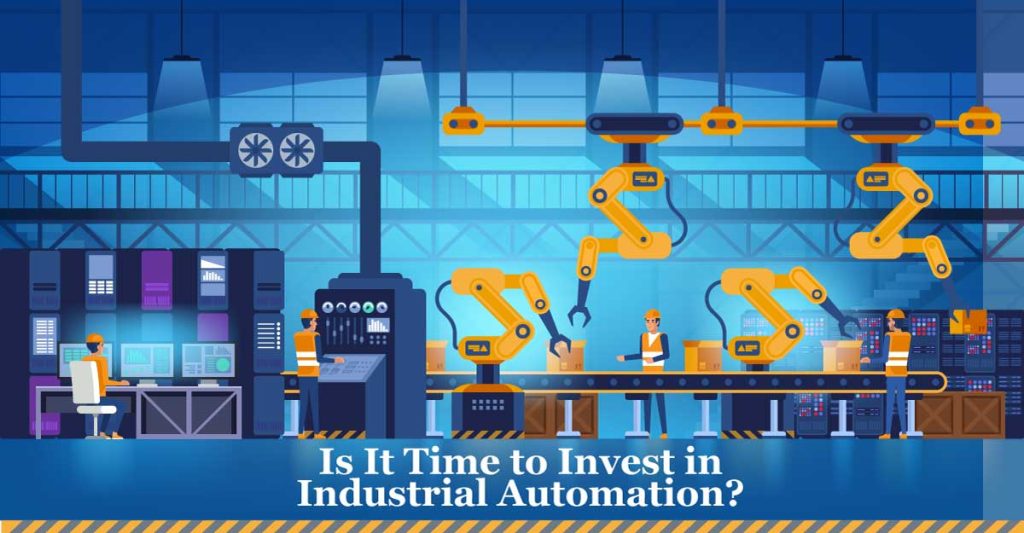
Table of Contents
Introduction of Industrial Automation
Firstly, artificial robotization controls ministries and processes used in colourful diligence by independent systems. Additionally, using technologies like robotics and computer software, industrial automation uses control systems, such as computers or robots, and information technologies for handling different processes and ministries to replace a mortal being. Moreover, it’s the alternate step beyond robotization in the compass of industrialization.
Robotization technology includes a wide range of tools and technologies. By integrating product lines or stand-alone robotization systems, data can be collected precautionarily to conserve outfits actively.
The History of Artificial Robotization started with simple conveyor belts pulling corridors through an assembly line. Machines performed introductory tasks and work that reduced homemade labour. Artificial robotization is a wide range of machines, selectors, detectors, processors, and networks that connect an artificial terrain. From PLCs, AI, Machine literacy, and IIoT bias, ultramodern artificial robotization is fastening on the stylish way to work technology. The following will introduce artificial robotization, its types, and its benefits: leading global diligence, expanding requests, and evolving competition.
Types of Industrial Automation
Manual control can be used to manage artificial processes. Machines can be operated robotically using computers and other electronic devices.
1. Fixed automation. 2.Programmable automation. 3.Flexible automation. 4.Integrated automation.
Fixed Robotization frequently has a set task, nonstop workflow, large volume product, and a high hedge of entry. Also called hard robotization, this type of artificial robotization infrequently sees changes. The expenditure and time associated with a new product or product changes are high. Programmable artificial robotisation will yield fewer benefits for lower volume or shorter product life cycles.
Frequently associated with batch products, programmable robotization works well for making several dozens to thousands of units. Further metamorphoses occur due to the lower product volume when batch sizes and lead times are determined. Companies work on improving uptime and introducing new products. These pretensions are leading to more flexible robotization.
As artificial robotization types progress, the processes involve lower mortal commerce and time-out while adding the range of products produced on one machine or product line. Flexible robotization frequently involves precise electromechanical controls; A CNC machine is a good illustration. Metamorphoses can automatically reduce winters. This works well for batch products but allows for a more in-demand product and increased customization.
Integrating Bias and machines into a single control system connects the blotches between processes, product lines, and more. Integrated robotization is a more holistic approach to manufacturing. As IIoT and Assiduity4.0 advance, independent machines and product lines are suitable for communicating on a network, becoming decreasingly flexible and moving towards in-demand manufacturing and increased customization.
A trend driving artificial robotization is covering biases that are quick and easy to integrate into any type of robotization. Real-time monitoring can produce data to make product opinions, acclimate the force chain, or manage labour. Monitoring will help decision-makers determine where and how artificial robotization will yield the topmost results.
Example of Industrial Automation ?
Advanced robotics can make pivotal opinions in manufacturing operations. Robotic and CNC machines are excellent exemplifications of the moment’s ultramodern robotization outfit. Automated bias can control events in various ways and increase effectiveness by covering data, which leads the product line to reduce waste.
A mortal hand takes control and does what needs to be done manually. Let us say we have a roaster that needs a certain quantum of heat but can not go over it. I have been assigned to reach and maintain the right temperature for 60 twinkles.
They periodically check on the roaster to ensure they don’t miss anything and understand the importance of supplying it with the required energy. With artificial robotization, however, everything takes care of itself.
Machines use faucets to control systems for energy force to different machine corridors. This stopcock opens when a computer detects a specific temperature. When the optimum temperature is reached, the machine closes to prevent excess gas from being fed and causing damage to other cylinders or pistons through overheating.
Once 60 tasks have been completed, as indicated by an alarm from the computer, another set of commands takes over automatically and completes all remaining tasks successfully; no mortal intervention is needed.
Importance of Industrial Automation
The importance of industrial automation in contemporary industries is paramount. Its significance extends across various dimensions, revolutionizing the way businesses operate. One of its primary contributions lies in the realm of efficiency enhancement. Through automation, tasks that once required extensive time and manual labor are now executed with precision and speed.
This not only accelerates production cycles but also optimizes overall workflows. Furthermore, industrial automation proves instrumental in cost savings. Through the reduction of manual labor and the efficient use of resources, businesses can achieve substantial financial benefits. The safety of the workforce is another critical aspect where automation shines. Machines can handle dangerous tasks seamlessly, minimizing the risk of workplace accidents. Overall, industrial automation is a linchpin for modern businesses, driving efficiency, reducing costs, and ensuring a safer and more streamlined operational landscape.
Advantages And Disadvantages of Industrial Automation
Advantage
Increased Efficiency: Automation speeds up production cycles, minimizing delays and boosting overall efficiency.
Cost Reduction: Manual labor costs decrease as automation optimizes resource utilization, leading to significant savings.
Enhanced Safety: Automation tackles hazardous tasks, reducing the risk of accidents and creating a safer work environment.
Quality Control: Precision and consistency in manufacturing processes improve product quality through automation.
24/7 Operation: Automated systems can operate continuously, contributing to increased productivity and output.
Data Accuracy: Automation ensures accurate data collection, reducing errors and enhancing decision-making processes.
Customization and Flexibility: Automation allows for easy customization of production processes to meet specific requirements.
Faster Production Cycles: Automated workflows are inherently faster, enabling quicker turnaround times for products.
Resource Optimization: Efficient use of resources such as materials and energy contributes to sustainable and eco-friendly practices.
Competitive Edge: Industries adopting automation gain a competitive edge in terms of speed, quality, and cost-effectiveness.
Dis-Advantage
- High Initial Costs: Implementing automation technology requires a substantial upfront investment.
- Workforce Adaptation: Employees may require training or upskilling to adapt to automated processes.
- Job Displacement: Automation can lead to job loss in certain industries, impacting workers with manual skillsets.
- Cybersecurity Vulnerabilities: Interconnected automated systems may be vulnerable to cyber threats, requiring robust security measures.
- Maintenance Challenges: Regular maintenance is essential for automated systems, and neglect can lead to downtime.
- Complex Implementation: Integrating automation into existing systems can be complex and time-consuming.
- Limited Creativity: Automation focuses on repetitive tasks, limiting its ability to perform creative or complex problem-solving activities.
- Dependency on Technology: Overreliance on automation may lead to challenges if systems fail or malfunction.
- Ethical Concerns: Issues such as job displacement and fair treatment of workers affected by automation raise ethical concerns.
- Resistance to Change: Some employees and industries may resist the shift towards automation due to fear of job loss or unfamiliarity with new technologies.
Increase Quality and Flexibility in Your Manufacturing Process
Before the purpose of robotization was to increase productivity( since automated systems can work 24 hours a day) and to reduce the cost associated with mortal drivers( i.e. stipend & benefits). still, moment, the focus of robotization has shifted to adding quality and inflexibility in the manufacturing process.
Pistons were manually installed into machines with an error rate of 1-1.5. But a more idiomatic and clear way to express this in active voice would be. An automated ministry currently performs this task with an error rate of 0.00001.
Automated systems were intended to enhance productivity and save costs in homemade operations in history. nonetheless, robotization is moving down from adding quality and inflexibility in manufacturing. In some cases, 1-1.5 piston fittings for buses were manually installed in the machine. Automated machines carry out this task, comprising around0.000- 11 crimes per hour.
Conclusion
Industrial automation, with its myriad benefits and transformative capabilities, is reshaping industries across the globe.The future of industrial automation holds immense potential, with ongoing technological advancements shaping a more connected, intelligent, and sustainable industrial landscape.Industrial automation has recently found more and more acceptance from various industries because of its huge benefits, such as, increased productivity, quality and safety at low costs.
Get Quote
Error: Contact form not found.

